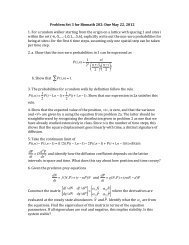340 T. ChouThe above symmetrization facilitates the calculation and computational convergence<strong>of</strong> the eigenvalues ρω 2 <strong>of</strong> A + ρΩqI 2 .We now input specific one- and two-dimensional periodic ‘surface potentials’ D(G −G ′ ). In one dimension, we consider strips <strong>of</strong> scatterers corresponding to a surfacesheet with alternating bending rigidities D(x) =D 1 or D(x) =D 2 depending onwhether x is inside or outside a strip, respectively (see figure 1a). For two-dimensionalperiodic surface scatterers, we consider both square (figure 1b) and triangular (notshown) lattices <strong>of</strong> circular disks <strong>of</strong> radius R 0 . Inside each disk, D = D 2 , whileoutside D = D 1 . The Fourier transforms <strong>of</strong> the above scattering potentials are,D( ⃗ 0) = D 0 ≡ ¯D =(1−f)D 1 +fD 2 , and⎫sin(|G|af), 1D periodicity, ⎪⎬D(G ≠ ⃗ 0) = D 2 − D 1π|G|D(G ≠ ⃗ 0)=2f (D 2−D 1 )|G|R 0J 1 (|G|R 0 ) 2D periodicity,⎪⎭(2.23)where f is the fraction <strong>of</strong> area covered by the D 2 material, and G is a reciprocallattice vector from the appropriate set in (2.14). Our choices above are numericallythe most laborious due to Gibb’s phenomenon at the sharp discontinuities in D(r);nonetheless, we find that the eigensolutions to (2.21) converge rapidly as a function<strong>of</strong> matrix size.3. Results and discussionWe numerically solve the eigenvalue problem represented by (2.21) and (2.22) foreach q (in the N i → ∞ limit, q becomes a continuous variable) using standardmethods described in Press et al. (1992). Typically, 256 different G (or (m, n) pairs) aretaken (corresponding to a 256 × 256 matrix) for both the one- and two-dimensionalcases, such that the lowest 4–6 eigenvalues do not change appreciably (< 1%) uponhalving the matrix size. The calculations converge very efficiently for the lowest 4–6eigenvalues especially in two dimensions because the additional Bessel function J 1makes the <strong>of</strong>f-diagonal elements diminish relatively faster away from the diagonal.The matrix calculations for smoother variations in D(r) are even simpler; for example,A is tridiagonal when D is sinusoidal. In our numerical plots, all distances are scaledwith respect to lattice spacing, and wavevectors are measured in units <strong>of</strong> a −1 . Thefrequency is non-dimensionalized and plotted in units <strong>of</strong> (g/a) 1/2 , and the bendingrigidity is shown in units <strong>of</strong> ρga 4 /π 4 .3.1. One-dimensional periodicityThe choice D 1 =0,D 2 ≠ 0 is appropriate for open water punctuated by flexible stripsand illustrates the difference between gravity and bending waves. For concreteness,consider D 2 =3.0, which for the Young’s modulus and Poisson’s ratio <strong>of</strong> sea ice(E =6×10 10 dynes cm −1 and s =0.3), and periodicities <strong>of</strong> 1.0 m, correspondsto a d ∼ 0.8 cm ice layer. At this coverage, the dispersion within the ice sheet ispredominately determined by bending forces (compare the terms gq and ¯Dq 5 /ρ)except at large wavelengths such that q (ρg/¯D) 1/4 .The first few eigenvalues, or bands, (labelled by n) in the dispersion relation for wavepropagating in an array <strong>of</strong> one-dimensional periodic surface scatterers are plotted infigure 2. Here, h = ∞, the filling fraction f =0.6, and D 2 =3.0. The right-hand panelshows the dispersion relation for q y = 0 as a function <strong>of</strong> q x , the reduced wavevector
Band structure <strong>of</strong> surface flexural–gravity waves 341654n = 6n = 5n = 4654ω3P 7P 8P 6P 5P 4n = 332P 3n = 2P 2P 1211n = 1P 005 4 3 2 1 0 p/2 p 0q xq xFigure 2. The dispersion relation, or band structure <strong>of</strong> surface waves (h = ∞) in the presence <strong>of</strong>discontinuous stripes <strong>of</strong> surface bending rigidity D(x). Lengths are measured in units <strong>of</strong> periodicitya and frequencies are measured in units <strong>of</strong> (g/a) 1/2 . Surface values used are σ =0,D 1 =0,D 2 =3.0,and filling fraction w/a ≡ f =0.6. The right-hand panel plots ω(q x , 0), the left, ω(0,q y ), whereω(q) =ω(−q). The dispersion relation (q y = 0) is plotted in the reduced-zone scheme where forexample, the first (n = 1) eigenvalues correspond to q x = k x , n = 2 correspond to k x = |G(1)|−q x ,n =3tok x =|G(1)| + q x , n =4to2|G(1)| −q x , etc. Note the first small band gap betweenω(P 1 ) ≃ 1.77 and ω(P 2 ) ≃ 1.79. Dispersion <strong>of</strong> waves with a component in the k y -direction areshown in the left-hand panel. Waves travelling in the ŷ-direction are described by the n =1eigenvalues, while n =2,3 correspond to k = ±q y ŷ + G(1).D 2 > D 1k = p/aFigure 3. Wave configurations (q x , 0) near the wavevectors <strong>of</strong> the first gap. The solid(dotted)modes are continuous with bands terminating at q x = π/a ± ɛ or P 1 (P 2 ).in the direction <strong>of</strong> periodicity. We have plotted the axis according to the reduced-zonescheme where the dispersion relations are folded at every half unit reciprocal latticevector G(1)/2, i.e. at (q x =0,π) where Bragg scattering <strong>of</strong> surface waves occurs. Thedifferent ω found from the eigenvalues correspond to wavevectors k x related to theplotted values <strong>of</strong> q x shifted by appropriate multiples <strong>of</strong> reciprocal lattice vectors G(1).If ω(k) were plotted as a function <strong>of</strong> physical wavevector k x instead, there would beone curve following P 0 − P 1 − P 2 − P 3 − P 4 − ..., as physical wavevector k x increased.The curve in this representation would be punctuated by discontinuous jumps atcertain wavevectors (multiples <strong>of</strong> G(1)/2) corresponding to Bragg scattering.The left-hand panel shows ω(0,q y ); only the lowest branch (n = 1) corresponds to awave propagating in the ŷ-direction. Interestingly, the motions corresponding to thismode have no variation in the ˆx-direction. For the set <strong>of</strong> parameters considered, thiswave has a predominantly gravity-wave-like dispersion. The higher branches n =2,3correspond to k = q y ŷ + G(1) and n =4,5 correspond to k = q y ŷ +2G(1).




